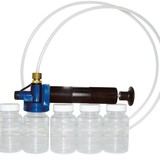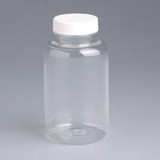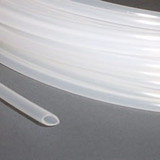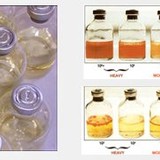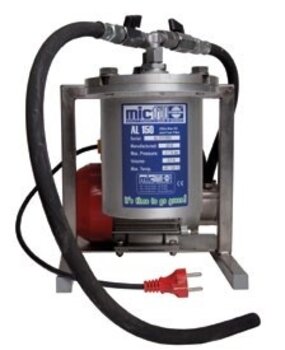Tank Cleaning
Microbial growth in fuel
Microbial contamination is not specific to any one fuel type - marine, aviation, automotive and home heating fuels are all susceptible. Similarly there is no single specific organism that can be identified as being responsible for degradation and spoilage. As a general rule, wherever fuel and water come into contact in a storage or distribution system microbial contamination is likely to occur.
No matter how well maintained a storage system is a water bottom is almost invariably present. This results from a number of sources:
· Freshly refined fuel contains some water. This separates out as the fuel cools down.
· Atmospheric condensation: humidity in the air in the storage tank condenses out and adds to the water bottom.
· Rain or snow may enter the tank via sampling ports, breather vents or ill-fitting seals on floating roofs.
· Transport or storage in tankers or barges can result in contamination from ballast water.
In addition certain end use applications - notably marine fuel - provide opportunities for water to enter a storage system. Water from all of these sources accumulates in the storage tank to form the water bottom.
Microorganisms can be air or waterborne. Consequently as the water bottom develops a microbial population builds up in it. For many of the species present in the water bottom, liquid hydrocarbon fuels represent an excellent nutrient source. As a result there is a population explosion: the microorganisms proliferate at the fuel/water interface, surviving in the water phase whilst feeding on the fuel.
In the initial stages of contamination the organisms present are predominantly aerobic, using the dissolved oxygen in the water for respiration. As this supply of oxygen is depleted, anaerobic organisms, known as sulphate reducing bacteria, develop. These organisms do not require oxygen for respiration and form corrosive waste products such as hydrogen sulphide.
CONSEQUENCES OF MICROBIAL GROWTH
Once a microbial population becomes established fuel quality rapidly deteriorates. As outlined below problems such as haziness, failure to meet specifications, corrosion, filter plugging and additive degradation can occur. All of these problems are related directly to the presence of microorganisms or their associated by-products.
Fuel Haziness:
This is a clear indication that fuel is out of specification. The primary cause of haziness is an increase in the water content of the fuel resulting from the production of biosurfactants. These are by-products of microbial growth and alter the surface tension at the fuel/water interface. As a consequence the solubility of water in the fuel is increased.
Degradation of Additives:
Certain additives, especially those rich in nitrogen and/or phosphorous, encourage microbial growth. In the process the additives are degraded and consequently their effect is lost.
Microbially Induced Corrosion:
Hydrogen sulphide is produced by sulphate reducing bacteria. This enters solution and is highly corrosive, causing severe pitting of fuel tanks and pipework.
Sludge Formation: Microbial debris is deposited on the tank bottom where it forms a layer of sludge. This sludge creates an environment which favors microbially induced corrosion. It may also become contaminated with viable microorganisms and unless removed will act as a reservoir of infection every time the tank is used.
Filter Plugging:
Biopolymers are formed during microbial growth. These are gummy products, which, along with microbial and other debris, are deposited on filters and pipes leading to reduced flow rates and blockages. At end user level this can have serious consequences causing engine damage and in extreme cases complete failure.
Odor:
A problem commonly associated with microbially contaminated fuel is that of foul odor. This is principally as a result of hydrogen sulphide production by sulphate reducing bacteria.
OTHER FACTORS INFLUENCING MICROBIAL CONTAMINATION
Although microbial spoilage and contamination occurs in a wide range of fuel types, some have been found to be more susceptible than others. For example, straight chain paraffins tend to be more readily degraded than aromatics and olefins.
The duration and conditions of storage are also important. If there is a low turnover of a stored fuel, such as in a strategic reserve, contamination is much more likely to develop. Poorly maintained or outdated storage facilities also present greater opportunities for contamination.
In the majority of cases, in addition to the microbial contamination at the fuel water interface there is a sessile population attached to the tank walls. This is frequently overlooked. Unless treated it will act as an innoculum reservoir for future contamination.
Source: Algae-X
Tank cleaning system for polluted diesel tanks. rental exclusive filters, biocides and transport
Tank cleaning system for ...
ACTICIDE® CMG Acticide CMG is a highly active biocide to prevent and combat bacteria in all types of fuels such as dies...
ACTICIDE® CMG Acticide C...
10µ Replacement filter element
10µ Replacement filter e...
Overige categorieën in Webshop
Tank Cleaning
Microbial growth in fuel
Microbial contamination is not specific to any one fuel type - marine, aviation, automotive and home heating fuels are all susceptible. Similarly there is no single specific organism that can be identified as being responsible for degradation and spoilage. As a general rule, wherever fuel and water come into contact in a storage or distribution system microbial contamination is likely to occur.
No matter how well maintained a storage system is a water bottom is almost invariably present. This results from a number of sources:
· Freshly refined fuel contains some water. This separates out as the fuel cools down.
· Atmospheric condensation: humidity in the air in the storage tank condenses out and adds to the water bottom.
· Rain or snow may enter the tank via sampling ports, breather vents or ill-fitting seals on floating roofs.
· Transport or storage in tankers or barges can result in contamination from ballast water.
In addition certain end use applications - notably marine fuel - provide opportunities for water to enter a storage system. Water from all of these sources accumulates in the storage tank to form the water bottom.
Microorganisms can be air or waterborne. Consequently as the water bottom develops a microbial population builds up in it. For many of the species present in the water bottom, liquid hydrocarbon fuels represent an excellent nutrient source. As a result there is a population explosion: the microorganisms proliferate at the fuel/water interface, surviving in the water phase whilst feeding on the fuel.
In the initial stages of contamination the organisms present are predominantly aerobic, using the dissolved oxygen in the water for respiration. As this supply of oxygen is depleted, anaerobic organisms, known as sulphate reducing bacteria, develop. These organisms do not require oxygen for respiration and form corrosive waste products such as hydrogen sulphide.
CONSEQUENCES OF MICROBIAL GROWTH
Once a microbial population becomes established fuel quality rapidly deteriorates. As outlined below problems such as haziness, failure to meet specifications, corrosion, filter plugging and additive degradation can occur. All of these problems are related directly to the presence of microorganisms or their associated by-products.
Fuel Haziness:
This is a clear indication that fuel is out of specification. The primary cause of haziness is an increase in the water content of the fuel resulting from the production of biosurfactants. These are by-products of microbial growth and alter the surface tension at the fuel/water interface. As a consequence the solubility of water in the fuel is increased.
Degradation of Additives:
Certain additives, especially those rich in nitrogen and/or phosphorous, encourage microbial growth. In the process the additives are degraded and consequently their effect is lost.
Microbially Induced Corrosion:
Hydrogen sulphide is produced by sulphate reducing bacteria. This enters solution and is highly corrosive, causing severe pitting of fuel tanks and pipework.
Sludge Formation: Microbial debris is deposited on the tank bottom where it forms a layer of sludge. This sludge creates an environment which favors microbially induced corrosion. It may also become contaminated with viable microorganisms and unless removed will act as a reservoir of infection every time the tank is used.
Filter Plugging:
Biopolymers are formed during microbial growth. These are gummy products, which, along with microbial and other debris, are deposited on filters and pipes leading to reduced flow rates and blockages. At end user level this can have serious consequences causing engine damage and in extreme cases complete failure.
Odor:
A problem commonly associated with microbially contaminated fuel is that of foul odor. This is principally as a result of hydrogen sulphide production by sulphate reducing bacteria.
OTHER FACTORS INFLUENCING MICROBIAL CONTAMINATION
Although microbial spoilage and contamination occurs in a wide range of fuel types, some have been found to be more susceptible than others. For example, straight chain paraffins tend to be more readily degraded than aromatics and olefins.
The duration and conditions of storage are also important. If there is a low turnover of a stored fuel, such as in a strategic reserve, contamination is much more likely to develop. Poorly maintained or outdated storage facilities also present greater opportunities for contamination.
In the majority of cases, in addition to the microbial contamination at the fuel water interface there is a sessile population attached to the tank walls. This is frequently overlooked. Unless treated it will act as an innoculum reservoir for future contamination.
Source: Algae-X


 Clean/Renovate
Clean/Renovate Exterior
Exterior Interior
Interior Sanitary
Sanitary Protect
Protect Deck/Hull
Deck/Hull Wood-Teak
Wood-Teak Metals
Metals Propeller
Propeller Stone
Stone Interior
Interior Health
Health BioOrg - Clean air
BioOrg - Clean air Fuel
Fuel Fuel Quality
Fuel Quality Conditioners
Conditioners Tank Cleaning
Tank Cleaning Remove/solve
Remove/solve Tests
Tests Technical
Technical Dive equipment
Dive equipment Electricity
Electricity Tools
Tools Engine
Engine Propeller
Propeller Lubricants
Lubricants Water
Water Pools
Pools Exterior
Exterior Permanon
Permanon  Star*Clean Metal Polish
Star*Clean Metal Polish Wood protection
Wood protection Interior
Interior KANBERRA GEL
KANBERRA GEL TECH SOLUTIONS
TECH SOLUTIONS ACCELL® CLEAN
ACCELL® CLEAN FUEL MANAGEMENT
FUEL MANAGEMENT HENCO Solutions
HENCO Solutions Matt Chem Marine
Matt Chem Marine PIPING & HOLDING TANKS
PIPING & HOLDING TANKS LFC Biodigester
LFC Biodigester Small LFC Biodigesters
Small LFC Biodigesters LFC-25
LFC-25  Powerchips Green
Powerchips Green  Powder Powerzyme™
Powder Powerzyme™ LFC Cloud
LFC Cloud WEP Effluent Pump
WEP Effluent Pump Downloads
Downloads Fuel
Fuel Biocides
Biocides Fuel quality
Fuel quality Health
Health Clean
Clean Protect
Protect Renew
Renew Technical
Technical ACCELL® CLEAN
ACCELL® CLEAN



